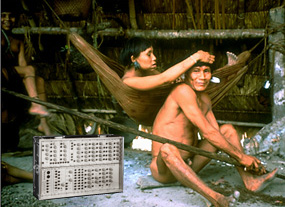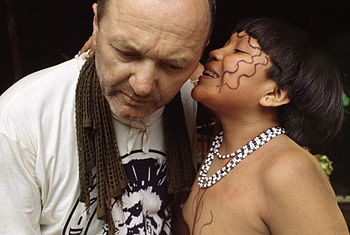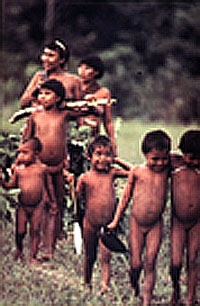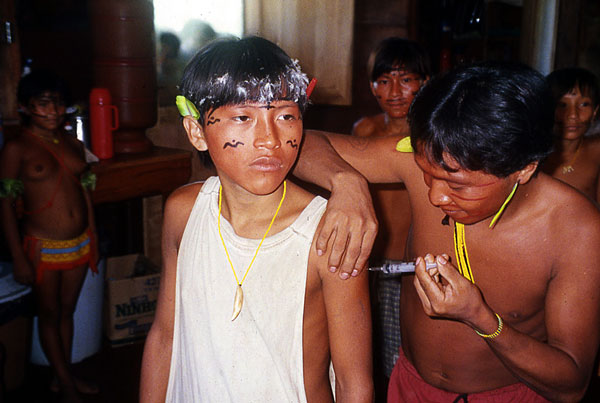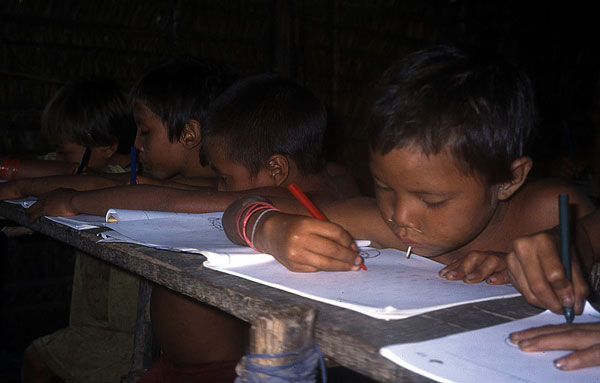Terms / Concepts
Notes
- Note: At the time of the filming the Salesian priest, Padre Cocco,
had been there 14 years
- language is now Spanish
- children are taken away from families for school
- skills
- farming
- cattle raising
- fishing
- sewing
- cooking /baking
- outboard motors
- making houses
- technology
- clothing
- western style (including one shirt with a motorcycle
on it)
- for sense and decency?
- food
- decrease in reliance on game
- imported manioc flour
- cattle
- the first cattle came in 1965, but there was
no bull
- fish
- increasing utilization of fish changed the division
of labor by sex re fishing
- chickens (but they don't eat them)
- beliefs
- hekura
- in Caracas it was too noisy for the hekura
- hallucinogens
- the men can "go for months without using" hallucinogens, therefore they are not addicted
- 70% of illness "is from beliefs"
- Catholicism
- transportation
- air strip
- increased number of visitors, and the number of
visitors continues to multiply
- outsiders include:
- missionary priests
- sisters (nuns)
- tourists
- built "hotel" for tourists
- anyone who comes to the Yanomamö will be well received
- and they give away much of what they have
to them
- maps appear, and change of geography
- How can you help incorporate them into the larger nation?
- little by little
- the missionaries consider their job to prepare them
so that when "civilization" hits them they
will be prepared
Cultures
Individuals
References
- The Anthropology Resource Center. 1981. The Yanomami Indian
Park: A Call for Action. Boston: MA.
- Baker, Paul. 1972. Review of 16 mm film, Yanomamö:
A Multidisciplinary Study. American Anthropologist,
74:195-196.
- Chagnon, Napoleon A. 1967. "Yanomamö -- The Fierce People."
Natural History Magazine 76:1:22-31.
- Chagnon, Napoleon A. 1968. "The Culture Ecology of shifting
(Pioneering) Cultivation among the Yanomamo Indians," Proceedings
of the VIII International Congress of Anthropological land Ethnological
Sciences, 3:249-255. (Reprinted in D. Gross, ed., Peoples
and Cultures of Native South America. Garden City, N.Y.: Doubleday.
- Chagnon, Napoleon A. 1968. Yanomamö The Fierce People.
NY: Bolt, Rinehart, and Winston.
- Chagnon, Napoleon A. 1968. "Yanomamö Social Organization
and Warfare in War: The Anthropology of Armed Conflict and
Aggression by Morton Fried, Marvin Harris, and Robert Murphy
(eds.). NY: Natural History Press.
- Chagnon, Napoleon A. 1972. "Tribal Social Organization
and Genetic Micro- differentiation," in The Structure
of Human Populations, G. A. Harrison and A. J. Boyce, eds.,
Oxford: Clarendon Press, pp. 252-282.
- Chagnon, Napoleon A. 1967. Studying the Yanomamö.
NY: Bolt, Rinehart and Winston.
- Chagnon, Napoleon A. "The Ecology of Swidden Cultivation in
the Upper Orinoco Rain Forest, Venezuela." The Geographical
Review 64:4:475-495.
- Chagnon, Napoleon A. 1972. "Tribal Social Organization
and Genetic Micro- differentiation," in The Structure
of Human Populations, G. A. Harrison and A. J. Boyce, eds.,
Oxford: Clarendon Press, pp. 252-282.
- Chagnon, Napoleon A. 1973. "Yanomamo," in Primitive
Worlds, Washington, D.C.: National Geographic Society, Special
Publications series, pp. 141-183.
- Davis, Sheton H. 1976. Victims of the Miracle: Development
and the Indians of Brazil. Cambridge Univ. Press.
- Davis, Sheton H. 1984. "Highways and the Future of the
Yanomamo." In Conformity and Conflict, Ed. by James
P. Spradley and David W. McCurdy, pp. 374-383. Boston: Little,
Brown.
- Hannah, Joel M. 1972. Review of Yanomamö:
A Multidisciplinary Study, American Journal of Physical Anthropology.
36: 453-454.
- Harris, David R. 1971. "The Ecology of Swidden Cultivation
in the Upper Orinco Rain Forest, Venezuela." The Geographical
Review, 61 (4) 475-495.
- Kensinger, Kenneth M. 1971. Review of The Feast, American
Anthropologist, 73: 500-502.
- Lizot, Jacques. 1985. Tales of the Yanomami. Cambridge
Univ. Press.
- MacCluer, J., J. Neel, and N. Chagnon. 1971. "Demographic
Structure of a Primitive Population: A Simulation," American
Journal of Physical Anthropology, 35:193-207.
- Neel, James V. 1970. "Lessons from a 'Primitive' People."
Science, 170: 815-822.
- Neel, J. V., W. R. Centerwall, N. A. Chagnon, and H. L. Casey.
1970. "In a Virgin-Soil Population of South American Indians,"
American Journal of Epidemiology, 91:418-429.
- Neel, J., et al. 1971. "Studies on the Yanomama Indians,"
Proceedings of the Fourth International Congress of Human Genetics. Human Genetics, September 1971, pp. 96-111.
- Neel, James V. and Richard H. Ward. 1970. "Village and
Tribal Genetic Distances among American Indians, and the Possible
Implications for Human Evolution," Proceedings of the
National Academy of Sciences, 65 (2):323-330.
- Salamone, Frank A. 1997. The Yanomami and their interpreters
: fierce people or fierce interpreters? Lanham, Md. : University
Press of America.
- Ward, Richard H. 1971. "The Genetic Structure of a Tribal
Population: The Yanomama Indians. V. Comparison of a Series of
Networks," Annals of Human Genetics.
- Yanomamö women -- MedLibrary.org
|

